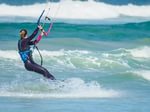He has traveled through sailing from winning six Mirror dinghy titles as a young teenager (and one more as a 40-something sailing with his daughter Zoe) to two Olympic medals and then victory in the 2014-2015 Volvo Ocean Race… but Ian Walker’s current day job as the racing manager of the Royal Yachting Association may offer some even bigger challenges.
In this report for Seahorse, Ian shares how changes in the sport are affecting the big picture:
I’ve always thought of myself as a young gun but as I approach my 50th birthday and watch my daughter sailing a 420 (as I once did) it is beginning to dawn on me that I am not so young any more.
I grew up sailing in the 1980s when many boats were still made of wood with Dacron sails, big regattas had one long race per day, there was no sponsorship allowed in Olympic sailing and a compass on your dinghy was as high tech as it got.
Primitive technology by today’s standards, but it is worth remembering that there were many national championships in the UK boasting over 100 boats, the Admiral’s Cup, SORC and Kenwood Cup were in their heyday, the Whitbread Race had 29 entries (1981), the 18ft Skiff class was expanding fast in Australia and we witnessed the best ever America’s Cups in Newport (83) and Fremantle (87).
The sport may be technically more advanced nowadays but it desperately needs to reverse the general decreasing trends in participation.
So what have been the biggest changes in the past 40 years since I first started racing? Here are my top 10.
1. New materials
The use of titanium, Dyneema, Kevlar, Mylar, carbon, epoxy and so on, and new design tools have changed boats, masts and sails beyond recognition. Nearly every development has made the boats we sail lighter, stiffer, stronger (once the technology has been worked out) and faster.
Once unthought-of power-to-weight ratios and improved design knowledge have transformed the boats that we sail. Apparent wind sailing is now the norm in many dinghies and keelboats and soon this will be foiling. Superyachts have got bigger and bigger and we have seen records tumble.
It is a genuine privilege to have lived through this era of unprecedented speed development. The only challenge is that most of these developments have led to an increase in costs.
2. The rise of the manufacturer one-design
As boatbuilding has taken advantage of new production methods and one-designs have proliferated, so the dominance of the larger manufacturers has grown in the dinghy and small keelboat market. Whether it be Laser, Topper, RS Sailboats, Ovington, J/Boats, Melges, or Bethwaite, the power and influence of manufacturers have grown significantly. We are more reliant on them than ever as they not only produce the boats, but they increasingly run or support the classes and events.
3. Changing formats
Few would wish to go back to the days of long Olympic triangle/sausage courses but I suspect most Olympic sailors would vote to get rid of the ineffective medal race if they could. Where one two-hour race per day with 100 boats on the line was once the norm in Olympic sailing, we now see 30-40 minute races with as many as 3 or 4 races per day.
Smaller race fleet sizes often mean a need for a qualifying series, followed by gold and silver fleets and a medal race to conclude. This puts a huge pressure on the schedule that often leads to not much racing.
The best inventions of the past 40 years would have to be either the inner/outer loop trapezoid course that enables two fleets to race on the same course or the leeward gate that helps keep racing close.
I can’t help but think that the next step is for fleet racing to somehow learn from team racing where courses that never return to the same mark twice enable races to start every few minutes with over 100 races per day not unheard of.
4. Improved race management
Being a race officer has become a complex task. Formats are increasingly demanding – instead of having to lay three marks, set a start and wait for two hours for all the boats to finish, race officers need a very skilled team who have a full day – often running eight race starts per day with sometimes two or even three fleets racing on the course at the same time.
Systems have had to be developed to improve consistency and help reduce the likelihood of mistakes, which is just as well as sailors and coaches are increasingly keen to seek redress. One championship race area typically needs about 16 volunteers (excluding umpires and jury) to run the racing including start, finish and mark laying boats.
At each of the 2019 RYA Youth Nationals and the Volvo 49er, FX and Nacra European Championships we needed over 140 volunteers (plus RYA staff) to run these events. It is not easy to maintain this skilled volunteer base and even volunteers quite rightly expect to be housed and fed.
Typically half the cost of a major regatta could be spent on volunteer expenses. More complexity, more officials and a higher standard of racing comes at a cost. Big events are getting ever more expensive to host and beyond the reach of many clubs. This is highlighted by the lack of bids for World Sailing’s prestige regattas, the Youth World Championships and Combined Worlds.
5. Increased professionalism
Sailors have learnt that to win you have to fully commit yourself to the sport. The better you prepare your boat, your sails, body and mind the better your results will be.
In the 1980s most Olympic sailors would have had to hold down jobs to pay for their part-time sailing. Only countries with the support of their military might have had sailors sailing full-time.
Nowadays every top Olympic class sailor is sailing full-time and even Optimist sailors need to sail five days a week if they want to do well. State-funded, elite sport programmes, private patronage and commercial sponsorship have helped to support this at Olympic level, but the lessons inevitably trickle down to other forms of sailing. In small keelboats ‘privateers’ can take shortcuts to winning by hiring the best professionals but anybody wanting to do well can also now expect to have to put in many training days before regattas.
In my experience the chance of ‘freak wins’ has decreased as the top of the fleet have separated themselves from the rest through their own professionalism.
6. Coaching
Coaching was a rarity even in Olympic classes in the 1980s – I remember there typically being one coach or team leader per national team. At Olympic regattas today the usual ratio is 1 coach boat for every 2-3 competitors. That meant approximately 400 coach RIBs at Princess Sofia regatta this year (1,200 competitors) and over 100 coaches at the Volvo 49er, Nacra and FX Europeans in Weymouth (220 boats racing).
While generating great employment for ex-Olympic class sailors, this comes at a significant cost to competitors and federations. The good news at Olympic level is that it is a healthy income stream for regatta organisers who can charge coaches to come and effectively be their safety fleet. Many high-performance classes could not operate without all the coaches for safety reasons.
At the junior levels it is just as challenging. An increase in the duty of care placed on organisers and typical support boat ratios of one rescue boat per 10 competitors makes it hard to run junior regattas without the support of parental or private coach boats.
7. Changing role of the club
After the boom in small boat sailing in the UK in the 1960s and 70s club racing remained popular during the 1980s. Even tiny little inland clubs such as where I grew up regularly had 100 boats or more on the water and there were very strong local open meeting circuits all over the country. Fast forward to the current day and many clubs are struggling.
Often the club product hasn’t really changed and we face increased competition from both new and traditional sports like kiteboarding, climbing, cycling, skateboarding, surfing, SUP etc. As if that isn’t enough, clubs are having to come to terms with fundamental societal shifts such as increased working hours, Sunday shopping, the changing roles within the family, increased foreign travel, health and safety, social media, to name but a few.
8. Rise of singlehanders
Finding a compatible helm or crew can be hard and singlehanded dinghies make getting afloat a lot simpler. Less maintenance, less hassle, less cost – it’s no surprise that there has been a proliferation of singlehanded sailing.
Whereas most of my generation learned to sail by crewing for adults or older children, youngsters today are more likely to learn to sail in a ‘junior programme’ and more often than not in a singlehanded dinghy.
This probably means they are coached as opposed to learning the sport from others or by simply doing it. Junior programmes can be great fun but be careful when racing starts as kids do not want to go to school seven days a week.
Singlehanded sailing has its advantages but it is not as social for kids, it doesn’t cater for those who don’t wish to helm, it is not as popular among females and by the top of youth sailing it becomes extremely physical.
In my view too much emphasis on singlehanded sailing is a real risk to participation.
9. Presentation of the sport
Tracking, graphics, drones, GoPros have all transformed the way the sport is presented. Unfortunately what hasn’t changed is the ability to guarantee that a race starts on time and without that sailing will never be a viable live TV sport. The internet holds the key as it provides the platform for sailing to be shown on demand in your front room. To attract a wider audience we need human interest stories, real characters, national pride and political intrigue.
10. Separation of the top of the sport from its roots
In most sports the top of the sport plays the same game as the grass roots. In sailing this is no longer the case with the America’s Cup, SailGP, GC32 etc all seemingly practising an entirely different sport.
The boats are flying, not sailing, and there is little similarity between what pro sailors do in these events and what people might do in club racing. The sailors themselves look superhuman with gym work being every bit as important as time on the water.
While this new form of sailing is technically fascinating, it has failed to gain a wider audience despite the huge investment that has been made in it. Generally the faster the boats the less interesting the tactics.
If people cannot relate to the sailors or the boats then they will not be interested.
Where next?
The world is a hugely different place from what it was 40 years ago. Sailing is competing in an increasingly competitive market place for people’s diminishing time and money. Marketing sailing as an increasingly technical, fast, physical, elite, expensive sport is not currently working.
We need the inspiration provided by the pinnacle events and we need heroes, but we also need to think about what the sport looks like for the average weekend sailor.
What does the product of sailing represent? What does it mean to be a sailor? What is going to attract people to our sport? Sailing has an opportunity to market itself by extolling the virtues that it can offer as a sport. Sailing is for all ages, it should be social, fun, inclusive, challenging (mental and physical), healthy, sustainable, accessible, to name but a few qualities.
Sailing clubs need to position themselves at the heart of local communities and welcome families who may see the lifestyle benefits of their children taking up our sport. Who wouldn’t want their child to make new friends, have fun and learn independence, competitiveness, teamwork, creativity, confidence, courage, resilience?
Some may be single-minded enough to progress on to become Olympic champions, but to sustain a healthy sport we need many more simply to take part, join clubs, race, cruise or volunteer.
Above all else we need to develop ways of making the sport more affordable. Without this sailing will never be accessible enough to grow again.
Note: Seahorse, the dominant international magazine for anyone serious about their racing, is available by magazine subscription or iPad download: www.seahorse.co.uk/shop






Recent Comments